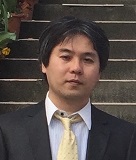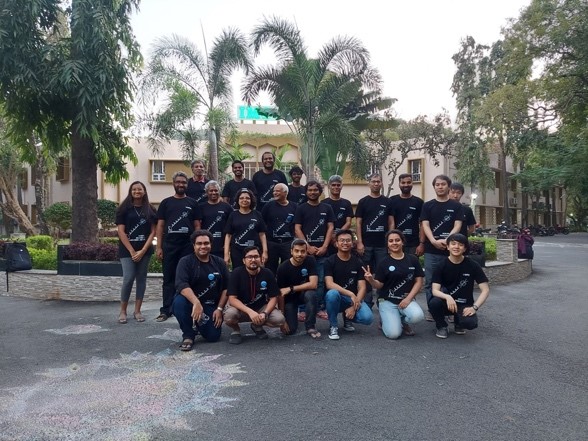STAFF

Dr. Keitaro TAKAHASHI
Professor, Faculty of Advanced Science and Technology
- Research Fields
- Astronomy, Astrophysics and Cosmology
- Featured Article
- keitaro[at]kumamoto-u.ac.jp
*Please replace "[at]" with @.
Research interest
Our Earth and Sun were formed a very long time ago, about 4.6 billion years ago. Actually, the universe itself started 13.7 billion years ago from the Big Bang and so the birth of our Earth and Sun was relatively recent in the whole history of the universe. One of the biggest mysteries in astronomy is when and how the first stars were born in the universe. It is theoretically expected that first stars were formed about 100 million years from the Big Bang but there is no observational evidence for that. In fact, such stars are located so distant from us that even the biggest optical telescopes cannot observe them. Thus, our group is attempting to probe the first stars by observing hydrogen gas which is the main ingredient of stars, not stars themselves, with radio telescopes.
The 21cm line emission from neutral hydrogen is a key quantity to understand the Epoch of Reionization, where the first stars and galaxies were formed and ionized the intergalactic hydrogen. However, due to the weakness of the signal, the presence of huge foreground and the interference of terrestrial radio waves, the 21cm line signal has never been detected so far. In this project, we aim to detect the 21cm line signal from the Epoch of Reionization for the first time, using a low-frequency radio interferemeter, Muchison Widefield Array (MWA), located in Australia.
In the 100 MHz band, in addition to this signal, there are foreground radiation such as galactic and extragalactic radio objects, and their intensity is much stronger than the signal. Therefore, precise removal of these foreground emissions is critical to signal detection. We will develop methods to estimate and remove the spectrum and spatial distribution of foreground radiation using advanced statistical methods such as sparse modeling. Further, avoidance of foreground with cross-correlation between 21cm line signal and galaxies will be pursued using machine learning methods such as artificial neural network.
Another important systematics is radio frequency interference, which is emitted from human civilization and reduces the sensitivity of the telescope. We attempt to identify and remove the radio frequency interference through machine learning. To do this, we conduct an experiment with two antennas with different directivity to remove the radio frequency interference through cross-correlation and apply the method to the observation of the MWA.

Murchison Widefield Array
Grants
科学研究費補助金基盤研究B(2021年度〜2024年度)・代表・直接経費:13,200,000円
Activities
Group photo at a meeting in Chennai, India

Members
| Postdoctoral Researcher | Nobleson KUNJAPPY |
|---|
Achievement
Publications
- 2024
-
- Improving DM estimates using low-frequency scatter-broadening estimates
- The second data release from the European Pulsar Timing Array V. Search for continuous gravitational wave signals
- Comparing recent PTA results on the nanohertz stochastic gravitational wave background
- Low-frequency pulse-jitter measurement with the uGMRT I : PSR J0437−4715
- A search for auroral radio emission from β Pictoris b
- The second data release from the European Pulsar Timing Array IV. Implications for massive black holes, dark matter, and the early Universe
- Multi-band Extension of the Wideband Timing Technique
- 2023
-
- Precision of localization of single gravitational-wave source with pulsar timing array
- Noise analysis of the Indian Pulsar Timing Array data release I
- The second data release from the European Pulsar Timing Array III. Search for gravitational wave signals
- The second data release from the European Pulsar Timing Array II. Customised pulsar noise models for spatially correlated gravitational waves
- Introduction to Faraday tomography and its future prospects
- Wavelets and sparsity for Faraday tomography
- Testing the non-circularity of the spacetime around Sagittarius A* with orbiting pulsars
- 2022
-
- Nanohertz gravitational wave astronomy during SKA era: An InPTA perspective
- On the Potential of Faraday Tomography to Identify Shock Structures in Supernova Remnants
- The Indian Pulsar Timing Array: First data release
- Low-frequency wideband timing of InPTA pulsars observed with the uGMRT
- A Parkes "Murriyang" Search for Pulsars and Transients in the Large Magellanic Cloud
- Constraints on ultra-low-frequency gravitational waves from an eccentric supermassive black hole binary
- Axion Cloud Decay due to the Axion-photon Conversion with Background Magnetic Fields
- 2021
-
- Constraining the 21cm brightness temperature of the IGM at z=6.6 around LAEs with the Murchison Widefield Array
- Evidence for profile changes in PSR J1713+0747 using the uGMRT
- Predicting 21cm-line map from Lyman α emitter distribution with Generative Adversarial Networks
- A new MWA limit on the 21 cm Power Spectrum at Redshifts ∼ 13 – 17
- Constraints on ultra-low-frequency gravitational waves with statistics of pulsar spin-down rates II: Mann-Whitney U test
- STAFF
-
- Wei XU
- Shinichiro Sawa
- Tetsuya KIDA
- Armando T. QUITAIN
- Junhua WANG
- Yoshihiro SEKINE
- Akira UEDA
- Yusuke INOMATA
- Muhammad Sohail AHMAD
- Jonas Karl N. AGUTAYA
- Nobleson KUNJAPPY
- Prafulla Bahadur MALLA
- Mohammad Atiqur RAHMAN
- Reetu Rani
- Kei TODA
- Tomoyasu MANI
- Agus Pulung SASMITO
- Tung Thanh TRAN
- Dario ZAPPA
- Daniel P. ZITTERBART
- Mitsuhiro AIDA
- U Rajendra ACHARYA
- Dmitri Aleks MOLODOV
- László PUSZTAI
- Yufeng ZHENG
- Gaochuang CAI
- Masahiko FURUTANI
- Hiroki MATSUO
- Zhongyue ZHANG
- Adam Karl SCHWARTZKOPFF
- Takashi ISHIDA
- Takumi HIGAKI
- Takahiro HOSONO
- Kei ISHIDA
- Makiko KOBAYASHI
- Ruda LEE
- Yuta NAKASHIMA
- Shin-Ichi OHIRA
- Atsushi SAINOKI
- Mitsuru SASAKI
- Keitaro TAKAHASHI
- Suttichai ASSABUMRUNGRAT
- Josep-Lluís BARONA-VILAR
- Nicorae BARSAN
- Jorge Norberto BELTRAMINI
- Olivier BOUTIN
- Paul BOWEN
- Pierre BREUL
- Maria Jose COCERO
- Patrice DELMAS
- Martin DIENWIEBEL
- Martino DI SERIO
- Derek ELSWORTH
- Carolina ESCOBAR
- Bruno FAVERY
- Etsuko FUJITA
- Tomonari FURUKAWA
- Jens HARTMANN
- Mohammad Abul HASNAT
- Yang JU
- Hoon KIM
- Ick Chan KWON
- Wen-Shing LEE
- Youn-Woo LEE
- Pavel LEJČEK
- Dongfang LIANG
- Bo LIU
- Tao LIU
- Hui LU
- Reiko ODA
- Yong Il PARK
- Shie-Ming PENG
- Christian RENTENBERGER
- Parasuraman SELVAM
- Amir SI LARBI
- Konstantinos Daniel TSAVDARIDIS
- Gioacchino (Cino) VIGGIANI
- Thomas WAITZ
- Yan XIAO
- Zhenghe XU
- Kazuki TAKASHIMA

